- Getting around Lijiang. Dont stay in the Old Towns more than 2 days, there is nothing to do. KRISS Oct 9, 2013 05:46
- 2013 Beijing Temple Fair BENNYLAU Feb 26, 2013 03:29
- Malaysian traveling from KUL - LAX vis Shanghai PVG ZATI_DY Jan 3, 2013 20:15
<A> AN ANCIENT CITY WITH MODERN CONNECTIONS
- Views: 4195
- |Vote: 0 0
- |Add to Favorites
- |Recommend to Friends
A little background history
The May holiday 2005 was fast approaching and I had planned to travel with one of my young and adventurous Chinese friends but we still didn’t know where we would go – somewhere not too crowded, I hoped. I asked her where she wanted to go and her reply was the ‘ancient town of Langzhong, have you heard of it’. No, I thought. ‘Ok’ I said I would have a look on the ’net and see if I could find something of interest about this ‘unheard’ of place.
Now let me back up a few years to the time I was preparing to come to work in China. Back home I have a friend whose parents worked in China for many years. She herself was born in a Japanese POW camp in Shandong Province in 1943 while her family was interred during the war. After liberation the family moved to Sichuan where her father worked in the Mission Hospital in Baoning on the Jialing River. The only way to get there was by boat up the Yangtze river to Chongqing and then the Jialing to Baoning also known today as Langzhong. My friend was 5 years old at that time and they remained in Baoning until all foreigners were asked to leave China in 1951.
As I would be working in Chongqing my friend asked if I might find the city and perhaps visit there one day. So the more I looked at Langzhong, the more surprised I became that this was the same city where my friend had lived nearly 50 years ago. I had been looking unsuccessfully for this place for more than two years and hoping to visit it one day and here it was, a place of historical, cultural and personal interest to me and my young friend wanted to go there too.
Langzhong is famous for many things
Historical buildings
· The Old City Quarter, one of the largest and best-preserved cities of ancient 'siheyuans’ or ‘courtyard homes’ in China today is literally cupped in a U-shaped bend of the Jialing River (a tributary of the Yangtze). Many have been renovated and opened as accommodation houses of varying quality. Most of these large beautifully restored homes of once prominent wealthy city merchants are also open to the public for a small fee.
· The BaBa Temple (Mosque) on a small hill beyond the bus station is unusual in that one entrance leads through a cemetery, rather strange and spooky if you visit at dusk and certainly not usual for a Temple to have a cemetery nearby. A closer inspection of the gravestones revealed Arabic text and although the style of buildings were similar to most other temples, this one had a very distinctive bell shaped dome on the roof of the central building. There was also no entrance fee and no admittance into the inner places of worship.
· The Gong Yuan or Qing Dynasty Imperial Examination Rooms is now a museum and reportedly the best preserved of the only two remaining, intact Gong Yuan is all of China.
· The Huaguang Tower, a city gate by the river affords excellent views across the river and over the gray tiled roofs of the Siheyuans, it’s worn steps a testimony of the passage of time and history.
· Jiang Fie Temple dating back 1700years is where this legendary figure is buried with many other tributes to him scattered all over southwest China.
Food and drinks
· Vinegar which you can add to everything, including food and drinks, and yes beer, medicinal and aphrodisiac tonics
· Baoning sweet steamed buns.
· Zhiang Fei dried beef (jerky)
· Pickled vegetables
Natural scenic spots
· Gouxi River wetlands area where we took a cruise up the river and back for the afternoon.
. Shitan Reservoir
Silk products
· Doonas
. Silk rugs
· Clothes
· Silk worms in chili
The Christian influence
But one thing it is not famous for is the 2000 seat Anglican Cathedral built around the turn of the last centaury. I had come to see if the Cathedral and the Mission Hospital were still standing. Incidentally neither of them was marked on our map. Whilst following directions given by the pastor of the much smaller church on the edge of the old town we went off looking for the Cathedral On a chance glance down a driveway something caught my eye. It was a cross in the metal arch above a gate, slightly obscured by a creeper, but could this be it? Nothing like a ‘Cathedral’ visible from where we stood, so we headed in to ask and found that this was in fact the administration offices, outside the back gate and garden.
The Red Army was headquartered here briefly during the war and many religious sites across the country were destroyed or vandalized in their wake. I was amazed at the size and simple beauty of the building as we caught sight of it from the back garden gate. Although a little unkempt around the grounds, it had minor restorations but was well maintained. It is well used, hosting a wedding the day before our visit and holds 2 services each Sunday with up to 1000 in attendance. There is a gravestone in the grounds recording the deaths and burial of a couple in the 1920’s
Then it was off to find what was left of the hospital if anything. Again built around 100 years ago it was a long shot. It’s now called the People’s Hospital, like so many around the country and although it is being upgraded we were pleasantly surprised to find one of the original buildings still standing. It was originally the theatre and wards but is now used as residence for retired staff. We came across a dear lady, an 88 year old believer who came as a young nurse in 1952, still living on the ground floor of the building. She explained that the old residential buildings had been demolished only two years ago to make way for the new hospital building. Rubble is all that now remains. Langzhong has a large community of both Christians and Moslems and a healthy religious tolerance to all.
One final surprise
Another surprise for us in Langzhong was the presence of the Huang Bao Che or the Rickshaw, literally translated ‘yellow covered chariot’. This is the only place I have seen any that look reasonably authentic. One man had caught my attention because he was always smiling, always busy and never once hustled us for a ride. He just happened by at that time we were considering taking a turn around the city on our last evening. So off we went with two in the ‘chariot’ and me on the bicycle taking turns riding and pulling ourselves around town, stopping to take photos and visit some of the ‘old family courtyard homes’, with their red lanterns, oozing with ambience and history. It was a wonderful and fun way to finish off an extremely interesting few days holiday.
Vinegar and Sweet bun specialties
On our last morning we headed out on borrowed bicycles, from the store where we bought some bottled water, for the famous Vinegar factory. We were shown around the factory without them spilling any secrets about this ancient brew (excuse the pun), were given gifts of both medicinal and aphrodisiac vinegar, a couple of books (in Chinese of course) about the history of the place, in exchange for a photo shoot with a ‘respected foreign visitor’. By the way the ‘aphrodisiac’ is extracted from the male silkworm moth. One of the oldest buildings in their compound was the merchant traders business house during the city’s heyday and is a great piece of architecture.
Our last stop was the also famous Baoning sweet steamed bun bakery that recently moved from the old quarter down by the river. Here I was invited to sit down with the professional ‘bun production team’, 25 years experience a piece and have a go at it. Of course it’s much harder than it looks but they seemed pretty impressed with my attempts. The factory can produce 10,000 of these little buns each day. Quite delicious when hot out of the oven and each one gets a red stamp by hand to prove its authenticity. I might add that this was probably the best food we sampled in Langzhong. We never did find anywhere to get a decent feed except for fried rice and the hand stretched noodles. Don’t miss the delicacy of silk worms in chili. I tried them, a once in a lifetime experience and a little gritty for my taste.
Location
Located four hours north of Chongqing and a similar distance east of Chengdu via Nanchong, Langzhong makes an interesting detour on route from Chengdu to Xian. There’s certainly something here for everyone. It’s flat so it's a good place to borrow or hire a bike and I’ve only mentioned some of the many things you can see and do in the area. The local's are friendly and while it sees it's far share of Chinese tourists we were never hustled by shopkeepers which is a pleasant change. Silk doonas are a great bargian here. Huang Bao Che is Y20 for two by night and Y30 by day.
More photos
Want to see more of Langzhong?
Why not view my photo series of Old Langzhong



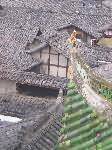
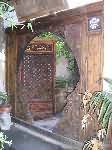
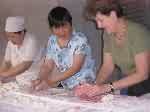
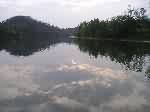
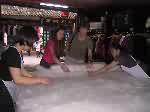
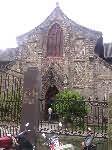

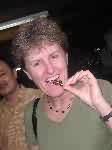
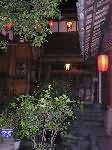
 Copyright © 1998-2025 All rights reserved.
Copyright © 1998-2025 All rights reserved.
1.
Feb 10, 2015 11:30 Reply
Mr.SCOTT from UK said:
Very interested in your comments. I grew up in Langzhong in 1936-1939. Went back for a visit in 2010. As you say the city is one of the few old towns left in China. There is also a Ming dynasty Pagoda. Can you let me know the name of your friend who was born in camp in Shandong and went to Langzhong with parents until 1951?
Basil Scott
Cambridge, UK
Nov 10, 2015 06:25
Mr.HOWE from United Kingdom replied:
Hello Mr Scott. I'm sorry I cannot answer your question, though I have known people who were imprisoned at Weixian in Shandong in the 30s and 40s. I am interested in the fact that you were in Langzhong/Baoning from 1936-9, depending on how old you were, you may have some very interesting memories of it? Also do you know anything specifically about Dr MR Lawrence who was there, a decade before you (1922-7)?
Many thanks.
Mr Howe (M.Phil., Cantab.)